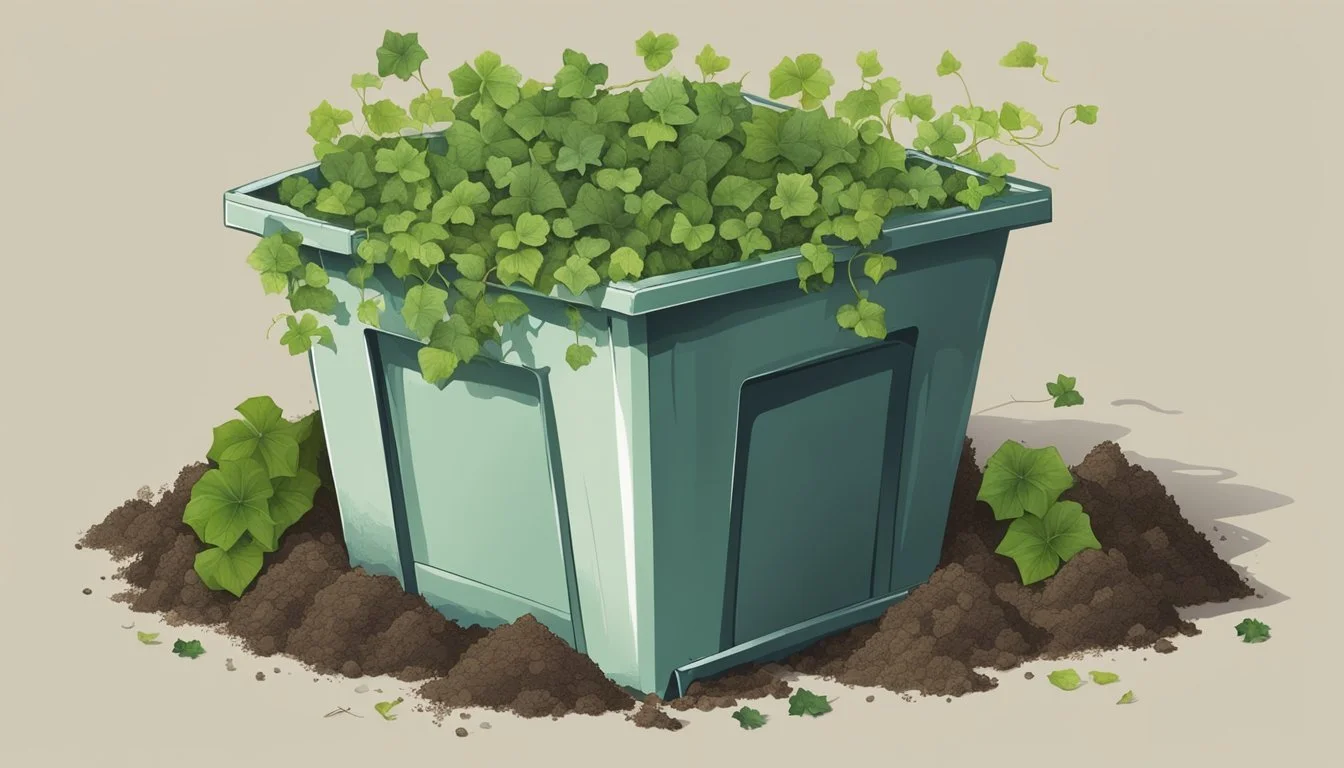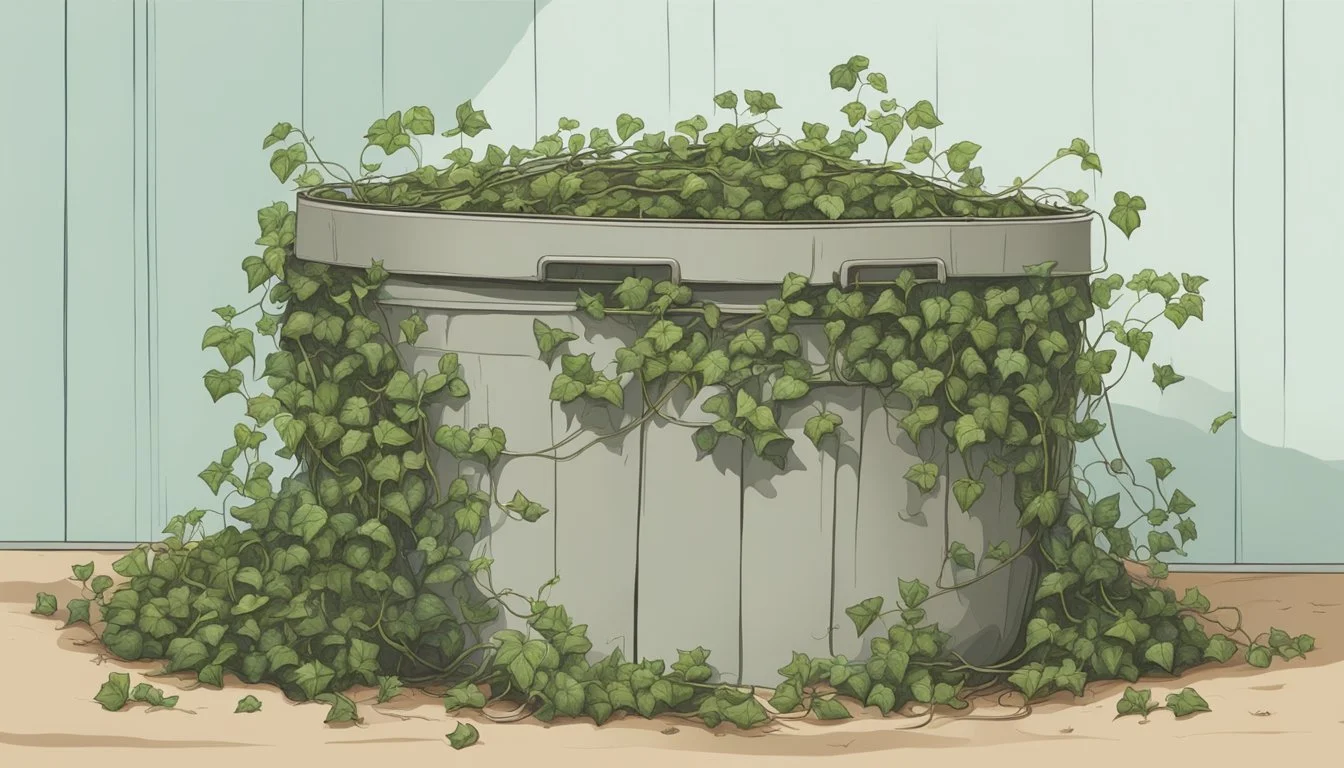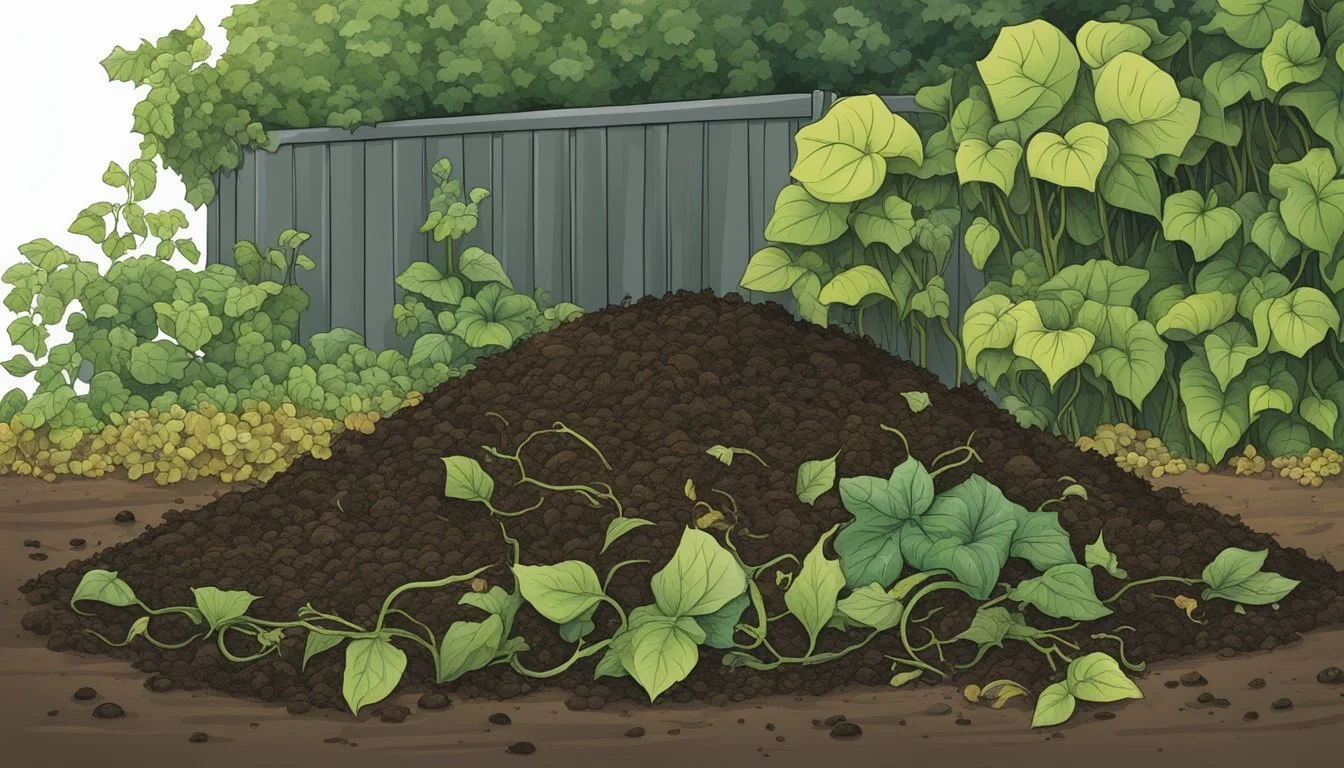Can You Compost Ivy?
Understanding the Pros and Cons
Composting is a sustainable method of turning various organic waste into nutrient-rich soil amendments, which gardeners often use to enhance plant growth and soil health. However, when it comes to composting certain plants, gardeners may encounter challenges. Ivy, a vigorous and hardy plant known for its fast growth, is one such example that raises the question of its suitability for composting.
While ivy can be composted, it requires particular consideration. Due to its resilient nature, ivy has a high potential for regrowth — even when cut and placed in a compost pile. This characteristic means that if ivy is added to a compost heap without proper preparation, it could start to grow within the compost environment rather than decompose as intended. Therefore, it's advised to treat ivy differently than other green waste before incorporating it into the compost bin.
To ensure that ivy breaks down instead of taking root in the compost pile, certain steps can be taken. It is recommended to thoroughly dry ivy out or to cut it into small pieces to accelerate decomposition. This prior treatment helps prevent the ivy from regrowing and becoming invasive within the compost, potentially overwhelming the pile and undermining the composting process.
Understanding Ivy and Its Growth Characteristics
Within the plant community, ivy is known for its robust growth and how challenging it can be to manage. This section explores ivy's various types, rapid growth patterns, and potential environmental impacts.
Types of Ivy
Ivy refers to a number of climbing or ground-creeping plant species, with Hedera helix, commonly known as common ivy, being one of the most prevalent. There are variations among ivy types in terms of leaf shape, size, and growth habits, but many share similar characteristics making them hardy and adaptable in diverse environments.
Rapid Growth and Invasiveness
Ivy plants are notable for their rapid growth and ability to spread across large areas quickly. Their fast-growing nature not only allows them to climb up structures but also makes them invasive species in non-native environments. Due to their vigorous growth rate and capability to root easily, they can be difficult to control once established.
Environmental Impact of Ivy
The spread of ivy, particularly in environments where it is not indigenous, can have a pronounced impact. It often outcompetes native flora for resources and can lead to a decrease in biodiversity. Additionally, ivy can envelop structures and trees, potentially damaging them or stunting their growth. Its invasive tendencies necessitate careful consideration when planting and managing ivy in both cultivated and wild settings.
Basics of Composting
Composting is an essential process for converting waste into a valuable amendment for garden soil. It not only recycles various organic materials but also enriches the soil and benefits the environment by reducing landfill usage.
Composting Process Overview
The composting process involves the decomposition of organic waste material, transforming it into a nutrient-rich soil conditioner, often referred to as compost. This biological process requires the presence of microorganisms, which break down the components in the presence of oxygen (aerobic decomposition). The right balance of 'greens' and 'browns'—materials high in nitrogen and carbon, respectively—is crucial for effective composting. The 'greens' provide protein and moisture necessary for the microorganisms, while the 'browns' supply energy. The decomposition process produces heat, and a well-managed compost pile will reach temperatures high enough to kill weed seeds and pathogens.
Benefits of Composting for the Environment and Garden
Composting offers several benefits:
Reduces waste: Diverts organic materials from landfills, which minimizes methane emissions, a potent greenhouse gas.
Improves soil health: Enhances soil structure, promotes moisture retention, and encourages the presence of beneficial microorganisms.
Sustains the environment: Supports the natural cycle of nutrient reuse, leading to less dependence on chemical fertilizers.
Assists in carbon sequestration: Compost adds carbon to the soil, helping to store it and reduce the overall carbon footprint.
Benefits specific to gardening include:
Better plant growth: The rich nutrients in compost are essential for healthy plant growth.
Natural disease control: Healthy soil helps suppress plant diseases.
Compost Pile Composition: Carbon and Nitrogen Ratio
The ideal carbon to nitrogen (C) ratio in a compost pile is roughly 30:1, balancing carbon-rich materials like leaves, straw, and paper (browns), with nitrogen-rich materials like food scraps, coffee grounds, and grass clippings (greens). An appropriate C ratio is paramount for the microorganisms responsible for decomposition to thrive. If the pile is too rich in nitrogen, it may become odorous and break down too quickly, while an excess of carbon slows the decomposition process.
Carbon-Rich "Browns" Nitrogen-Rich "Greens" Dry leaves Vegetable scraps Straw Fruit waste Wood chips Lawn clippings Paper Coffee grounds
For effective composting, gardeners should construct their compost piles by layering these materials, turning the pile periodically to introduce oxygen and checking moisture levels to ensure that materials decompose properly without becoming overly wet or dry.
Pre-Composting Considerations for Ivy
Composting ivy requires careful handling due to its vigorous growth and potential to cause issues in compost piles. The key concerns to address include assessing the risk of regrowth and understanding ivy's effect on soil health.
Potential Risks of Composting Ivy
Ivy Regrowth: Gardeners should be alert to the fact that ivy roots and stems have the tenacity to regrow even when broken down into smaller pieces. This resilience can lead to ivy sprouting within the compost pile, potentially overwhelming it and causing a nuisance.
Root Persistence: When composting ivy, gardeners must ensure that roots are thoroughly dried or dead before adding them to the compost. Active roots may otherwise take hold in the compost pile, leading to unwanted growth.
Toxicity Considerations: Some types of ivy may contain compounds that are toxic to humans or animals. Gardeners should identify their ivy species and confirm it’s safe for composting to avoid introducing harmful substances into the soil ecosystem.
Ivy's Impact on Decomposition and Soil Health
Influence on Decomposition: Ivy, especially when shredded into smaller pieces, can decompose at a rate conducive to composting. However, its high density and fibrous nature may require a longer timeframe to break down completely compared to other organic materials.
Soil Health Contribution: As a composting material, properly processed ivy can eventually contribute nutrients back into the soil, functioning as a natural fertilizer. Nevertheless, gardeners must initially manage the ivy's aggressive growth traits for it to be a beneficial addition to the compost.
Balancing the Compost Pile: Incorporating a balanced mixture of green (nitrogenous) and brown (carbonaceous) materials with ivy can aid in maintaining an optimal composting environment. Ivy should only be added to the pile in manageable amounts to avoid imbalance.
Effective Methods for Composting Ivy
Composting ivy is possible when specific preparation and composting methods are utilized to counteract the plant's natural resilience and propensity for growth.
Shredding Ivy for Improved Decomposition
Shredding ivy leaves and stems before adding them to the compost heap significantly aids in speeding up the decomposition process. Finely shredded ivy:
Creates more surface area for microorganisms to work.
Helps to prevent the ivy from taking root.
To shred ivy, use a garden shredder or shears to chop the material into smaller pieces, ideally less than 2 inches in length.
Hot Composting Techniques
Hot composting is a method that generates enough heat to break down tougher plant material like ivy and even kill off any parts that might regrow. A successful hot composting process involves:
Balancing 'greens' (nitrogen-rich materials such as vegetable scraps) and 'browns' (carbon-rich materials such as leaves, straw, or wood chips).
Maintaining the pile's moisture levels.
Regularly turning the heap to introduce oxygen, which fuels the microorganisms that generate heat.
For hot composting ivy, ensure that the compost heap reaches temperatures between 140°F to 160°F, as this aids in killing off any living ivy vines.
Alternative Composting Methods
Besides traditional composting, alternative methods may also be employed:
Bokashi composting: This process uses a fermentation method that can break down ivy without the risk of it regrowing.
Municipal green waste facilities: These facilities often have industrial processes and equipment capable of handling invasive plants like ivy safely.
When using any alternative method, consider contacting the facility or thoroughly researching the technique to ensure it is suitable for composting ivy.
Incorporating Composted Ivy into Gardening
Composted ivy can provide valuable nutrients to garden soil when used judiciously as fertilizer or mulch. It is essential to ensure that the ivy has been thoroughly composted to avoid regrowth and that it is mixed appropriately with other materials in the compost.
Using Ivy Compost as Fertilizer and Mulch
Composted ivy serves as a nutrient-rich additive that can fertilize garden soil when applied properly. Here are the best practices for incorporating ivy compost:
Avoid Fresh Ivy: Ensure ivy is completely composted to avoid ivy cuttings from taking root.
Mix Thoroughly: Combine decomposed ivy with other organic materials in a 3:1 ratio to balance the compost mixture, using three parts other materials to one part ivy.
Application: Use composted ivy sparingly as a fertilizer, integrating it into soil to enrich nutrient content or as a mulch layer to suppress weeds and retain soil moisture.
The Role of Composted Ivy in Soil Nutrition and Plant Growth
Composted ivy can impact soil nutrition and plant growth in the following ways:
Soil Structure: The incorporation of ivy compost can improve soil structure, promoting better water retention and aeration.
Nutrient Content: As it breaks down, the composted ivy releases vital nutrients like nitrogen, potassium, and phosphorus, contributing to nutrient-rich soil conducive to healthy plant growth.
Microbial Activity: The addition of organic matter from ivy compost encourages increased microbial activity in the soil, further benefiting plants.
By following these guidelines, gardeners can successfully use composted ivy to enhance the fertility and condition of their garden soil, supporting a vibrant and productive garden ecosystem.
Practical Tips and Precautions
When composting ivy, it is crucial to control its invasive nature and to handle the plant material carefully to prevent it from potentially taking over the garden.
Handling Ivy Safely
One should always wear protective gloves and clothing to avoid skin contact with ivy, especially varieties like poison ivy that can cause irritation. Using long sleeves and pants can provide extra protection. It is important to prevent any pieces of the ivy from falling and taking root elsewhere in the garden.
Timing and Techniques for Cutting Ivy
The ideal time to cut ivy for composting is in the fall, when the plant's growth starts to slow. The vine should be cut into small pieces which helps to speed up the decomposition process. Material should be mixed with other greens and browns in the compost pile to maintain a balanced nutrient profile.
Maintaining the Compost Pile
A compost pile containing ivy requires regular maintenance to ensure proper breakdown of the material. It’s imperative to:
Turn the pile frequently to distribute air and heat evenly throughout.
Ensure an optimal level of moisture is maintained, providing the necessary environment for microorganisms to thrive and decompose the ivy leaves efficiently.
Regularly turning and monitoring the pile discourages ivy vines from reestablishing themselves and turning into weeds that could invade the garden.
Environmental Considerations and Best Practices
In managing ivy waste effectively, understanding the environmental benefits and region-specific composting approaches is essential. This ensures a reduction in waste and a positive impact on biodiversity.
Reducing Waste and Promoting Biodiversity
Ivy, when disposed of improperly, can lead to environmental issues such as unintended propagation, which competes with native species. Composting ivy must be approached cautiously to promote decomposition without affecting biodiversity. The goal is to reduce waste effectively by transforming ivy into beneficial compost without allowing it to regrow.
Before adding ivy to a compost pile, ensure it is dried out or dead to prevent regrowth.
Monitor the compost's temperature to ensure proper decomposition.
Considerations for Composting Ivy in Different Regions
Each geographic region has unique conditions affecting how ivy should be composted:
In the UK, where ivy is prevalent, local environmental conditions must be considered to adjust composting practices.
Composters should ensure the ivy has ceased to be viable to prevent spread in local ecosystems.
Environmental impact varies by region, influencing the composting process of ivy:
Region Consideration Warmer Climates Additional precautions due to higher regrowth rates Cooler Climates Longer decomposition times but reduced propagation risk
Council and Community Composting Facilities
These facilities often have the expertise and resources to handle ivy and other difficult to compost materials:
Council facilities may offer guidelines for pre-treating ivy before adding to communal heaps.
Community composting facilities are pivotal in reducing the environmental impact of waste by providing controlled environments for compost production.
Residents should inquire with local council or facilities for specific advice on composting ivy.
Challenges in Composting Ivy
Composting ivy requires an awareness of its unique characteristics which can make it a tenacious presence in compost heaps. Careful steps must be taken to prevent ivy from overtaking the compost and introducing undesired issues.
Controlling Regrowth and Spread
Ivy vines are known for their vigorous growth and ability to propagate from cuttings. This makes controlling its regrowth when added to compost piles problematic. To mitigate this, composters should:
Dry out ivy clippings thoroughly before adding to compost to inhibit growth.
Shred or chop ivy pieces to reduce their capability to take root.
Managing Pests and Diseases
Pests and diseases that affect ivy may carry over to the compost pile and subsequently to other garden areas. It is important to:
Inspect ivy for signs of pests or diseases prior to composting.
Avoid composting infected or pest-ridden ivy material to prevent spread.
Ivy's Resistance to Decomposition
The waxy coating of ivy leaves makes them resistant to decomposition. Gardeners can:
Balance ivy with green and brown materials to enhance composting.
Turn the compost pile regularly to increase aeration and encourage breakdown.
Finishing the Composting Cycle
When composting ivy, it's important to recognize when compost is ready for use in the garden, and how best to introduce this nutrient-rich material to benefit garden plants.
Determining When Compost is Ready
Visual Inspection: Ready compost should appear dark and crumbly, similar to rich garden soil.
Smell Test: It should have an earthy scent rather than any unpleasant odors.
Sieve Test: Passing the compost through a sieve can help separate unfinished materials which should be returned to the compost heap for further decomposition.
One should ensure the compost has cooled down and no recognizable ivy pieces remain, as these could lead to regrowth in the garden. The moisture should be similar to that of a wrung-out sponge, and compost should be free of any large clumps.
Using Finished Compost in Gardens
Soil Amendment: Incorporate compost into the garden soil by mixing it into the top few inches, which will help improve soil structure and fertility.
Mulching: Compost can also serve as an organic mulch, applied around plants to retain moisture and regulate soil temperature.
When introducing compost to the garden, one should be cautious with tender plants, ensuring the compost is thoroughly processed to avoid any damage from residual decomposition heat. For best results, the finished compost should be used during the planting season to provide immediate benefits to garden plants.









